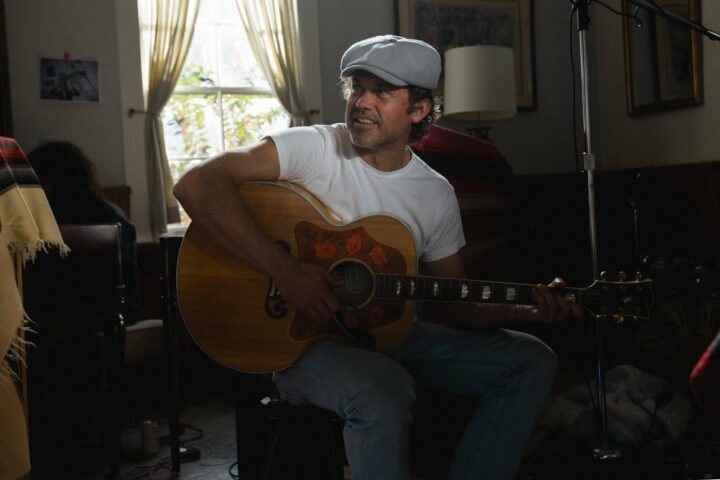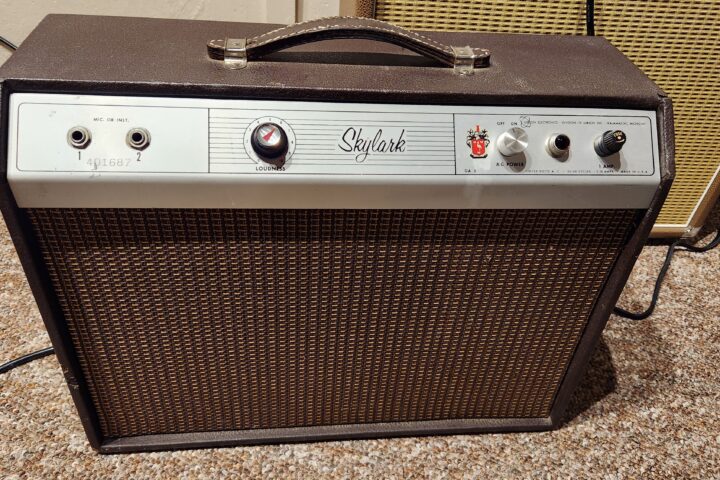I was working at Winnipeg’s infamous Blue Note Cafe on Portage Ave. (the place that Neil Young played at and named his band after) in 1998 and had an hour to kill before work started. It was a beautiful sunny afternoon and I took my ’69 Gibson Dove with me to work so I could have an hour to myself and get some flatpicking in. I was sitting on a picnic table across the street from the Cafe in Vimy Ridge Park, playing guitar, when I saw an obviously inebriated man stumble into the park about two hundred yards away.
He walked slightly sideways for twenty steps in one direction, then twenty steps in the other. At some point, he heard me playing over all the traffic noise, changed direction and started heading right for me. He was an older dude, in his early 60s, and looked like he had been through the mill, but he was dressed quite nice and was obviously taking care of himself in some ways.
He stood right in front of me and listened to me play for about two minutes, the entire time with a huge smile on his face. Then he slurred, “I’ve got a guitar just like that one at home. It’s so broken. Do you know anyone who fixes guitars?”
Well, asking me that question made me smile! I told him that I had had an instrument repair shop in the city for five years and that I would love to have a look at it. I packed up my guitar and we went to his place a few blocks away. His apartment was a pretty huge mess, but I saw a Gibson headstock sticking up from behind the couch. He pulled out this old totally beat-up Gibson Southern Jumbo and handed it to me.
It was still original: bridge, pick guard, original machines. It had no strings on it — probably because the headstock was broken – and its frets were worn right down to the beautiful inlayed board. I could hear rattling inside the guitar when I shook it. I looked inside and could find no back braces at all (there are supposed to be four of them)! I could feel softness in the top, too, some of the X braces were either loose or missing. There were no cracks anywhere, though, just lots of long pick scratches, a few big dings and the finish shattered like a good ’50s Gibson should be. And that old ’50s Gibson sunburst made me smile.
I did a quick estimate that it would take $600 to get it up and running. He told me he would talk to his brother who co-owned the guitar. I gave him my card and waited.
He never called back.
A few months later, I happened to be at his apartment block for something else and went and knocked on his door. A young woman answered and said he had moved out months ago.
Fast forward three years. I am again sitting in Vimy Ridge Park playing my ’69 Dove in the middle of the afternoon. I see a guy walk into the park. He’s slow and slightly limping, but arrow straight. He had seen me from far away and wanted to hear me play, or so I thought. This gent was totally disheveled, wore dirty clothes and his head leaned way over to one side. He looked like he had not had a haircut in a year.
He slowly walked towards me and then stood in front of me, saying, “I have a guitar just like that one. It’s all broke. Do you know anyone who fixes guitars?”
Well, you could have knocked me over with a feather.
I introduced myself again and asked if he remembered me. “Sorry about that last time,” he said. “I got evicted and lost your card. The old guitar has been sitting there without strings since ’61 when John dropped it and broke the handle part. I had a stroke this last year, and I sure ain’t ever gonna be playing no more. I just wanna sell the thing. Are you interested?”
I said I was, and we exchanged phone numbers. As he told me how much he wanted for it he said, “I’ll call you on Friday, and that’s for sure this time. My brother has the guitar right now and said he wanted to do something with it.” I waited for his call.
On Friday, he did call. He said, “Here’s my address. You can come over right now if you want. But I don’t think you’re gonna want it anymore. My brother did a bit of work on it and, well, you’ll see… I still want to get the same amount for it. Bring a guitar case, too, cause it’s gone now.”
I had no idea what to expect as I rode over to his place. I was pretty freaked out at what he had just said.
The axe was sitting on his couch when I walked in. I did not recognize it at all. It actually looked like a $45 dollar Japanese copy of a copy. I looked for another guitar in the room.
He reached for it and told me that his alcoholic brother had done the work on the guitar, and how unhappy he was when he saw it. The brother had taken the reverse belly bridge off and power-sanded all the lacquer off the entire body. On both the front and back of the guitar were horrible cracks! The front had six big ones that I could see: one went from beside the treble side of the fretboard right to the other end of the guitar, two of them went through the entire length on the back. For some reason that I’ll never understand, he had applied about 10 coats of black shoe polish to the entire fingerboard and headstock.
The brother was not finished. He then bought a brand new set of classical machine heads, turned the guitar on its front, mounted the machines and drove all the fancy gold plated screws all the way in, snug. The problem was that they were 1″ screws! All 12 of the screws were protruding out the front of the totally black headstock by about a half an inch!
I bought it, of course. It took me three years to get all the work done on the guitar. The back at some point has been submerged in water. All of the braces popped out and were nowhere to be found. The back had also developed an arch from side to side from the water, and could not be flattened. I had to make chalk-fitted, arched braces for the back. The X bracing was only partly attached, so I did all that work, too, thankful that those braces were still attached.
I was able to get all ten layers of black shoe polish off and thankfully he had not sanded the front of the headstock! The fretboard and headstock cleaned up nicely. The broken headstock repaired beautifully, and there is no evidence today that it was ever broken. (They had the sense to take the string pressure off it, as so few people know to do.) I drove black dyed maple toothpicks into the holes left by the screws through the front of the headstock, and did some black lacquer touchup on them, too. The refret job was pretty standard for a guitar with binding, and for a change, not a single problem came up. Of course, cleating all those top and back cracks, was a job in itself that I will not soon forget.
The original bridge was broken in half at the saddle, and I wondered if I could fix and re-glue it. But that was what I did! (I know I know: real repair folk would never re-glue a bridge that was broken in half. I did it anyways, as I had never made a bridge before. I knew at some point later on, I would know how to do that work.) I put the bridge in a paper bag and put it inside the guitar until it had some finish on it.
The last thing that stopped me cold was putting some kind of a sunburst on it, because it was all I had in my head for that guitar. So, I put it away, until I learned more. I tried to find someone to do the ‘burst for me, but after showing the axe to a few seasoned luthiers, I knew I was out of luck.
Three years later, it was still sitting in its case, and I finally had enough. I got out a few cans of spray paint, and a few small bottles of Tru-Oil, and sunbursted the top as best I could without any adult supervision. I did several coats of Tru-Oil on the rest of the guitar also.
The sunburst was more than laughable, as you can see from the pictures. I decided right then and there that I could live with a really ugly guitar… if it would play in tune. I had high hopes that that would be the case. I also decided that after it had strings on it, the guitar would never leave my living room.
At long last, I glued the bridge on, and waited 24 hours. I noticed how light the guitar was at that point, and wondered how much sawdust the guy had generated when power sanding the poor guitar.
The next day, after waiting 40 years to be strung up, I put a set of 13-56 strings on it, brought it up to pitch, and thought, “Here is just one more wall hanger for me.”
To say that I was not at all prepared would be an understatement!
It was super loud, with a rumbling tubby tone. It had plenty of highs, mids and lows. I hit an E chord and that mahogany back vibrated my tummy! After all this work, I was prepared to laugh at the guitar, but soon I was laughing with joy! I realized that this guitar left all my others in the dust!
I now had a new main guitar! And, for the next eight years, it remained my main axe. Surprisingly, it was hardly affected by humidity levels at all. And it always played in tune! The only negative was that the center seam crack in the top opened up every single winter, yet it never seemed to affect the sound.
Everything was great for eight years, until one day I could not get it to stay in tune. I did a quick survey and could not find anything wrong, but it just would not tune up. All the work on the Southern Jumbo had not prepared me this. Frustrated and sad, I hung the Gibson up on the wall for a while until my temper cooled down.

I took a whole year off from that guitar before I had a good look at it. I found that the bridge plate had become 100% un-glued. I made a new plate, and phoned Terry Flagell, my instrument repair mentor here in Prince George, British Columbia. I asked Terry if he would be willing to shoot a sunburst on it. I told him I would carefully strip it and he would just have to do the finish work. He agreed. I was about to get that sad looking guitar back up to 1952 specs!
I carefully scraped/sanded the top and sent it to Terry six weeks ago. I just got it back yesterday. It will be curing for the next four weeks… more to come!
—-
Have a good guitar tale to share? We’d love to hear it. Email us at fretboardjournal@gmail.com.


